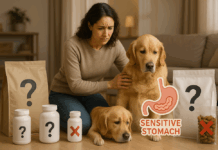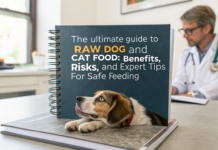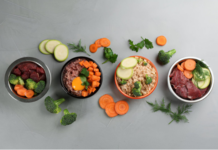Last Updated on June 10, 2024 by Dogs Vets
Raw pet food – is it worth the hype?
Raw pet food is a hot topic in the pet industry, with more and more pet owners choosing to switch their furry friends to a raw diet. But what exactly is raw pet food? Why is it so popular? And is it really worth all the hype? In this blog post, we’ll explore the world of raw pet food and answer these questions and more!
What is a Raw Dog Food Diet?
A raw dog food diet, also known as a raw food diet or a BARF (Biologically Appropriate Raw Food) diet, involves feeding dogs uncooked ingredients instead of processed commercial dog food.
This approach to canine nutrition is based on the belief that dogs should consume a diet similar to what their ancestors – wild wolves – would eat in the wild.
Primary Ingredients
A raw dog food diet typically consists of raw meat, organs, bones, fruits, and vegetables. These ingredients are often sourced from various protein sources such as beef, chicken, turkey, fish, and lamb. Some raw feeders also include eggs, yogurt, and supplements like fish oil or probiotics to provide a well-rounded nutritional profile.
Ideology behind the Diet
Advocates of raw dog food diets believe that raw ingredients offer several benefits for dogs. They argue that uncooked food retains more nutrients, enzymes, and natural antioxidants compared to processed commercial dog food.
By feeding a raw diet, pet parents aim to mimic the natural diet of canines and provide a more biologically appropriate and species-specific nutrition.
It’s important to note that the raw dog food diet is not without controversy. Some veterinarians and pet nutrition experts raise concerns about the potential risks associated with this feeding approach, such as bacterial contamination and nutritional imbalances.
Therefore, it’s crucial for dog owners to research and consult with a veterinarian before deciding to switch their dog to a raw food diet.
Is a Raw Dog Food Diet Worth it? Exploring the Benefits and Risks
Imagine your furry companion wagging their tail with boundless energy, their coat gleaming with vitality. This idyllic scene is what many pet parents envision when considering a raw dog food diet. But is this nutrition trend truly worth the buzz it generates?
Delving into the world of raw feeding for dogs unveils a realm of benefits and risks that every responsible pet owner should weigh carefully.
In this blog, we dissect the essence of incorporating a raw food diet into your dog’s meals, shedding light on the potential advantages and caveats that come hand in hand with this choice.
From the promise of a shinier coat and improved overall health to the lurking concerns of bacterial contamination and nutrient imbalances, we navigate through the maze of information to help you make an educated decision regarding your furry friend’s well-being.
Join us on this insightful journey as we combine personal experiences, scientific reviews, and expert insights to provide you with a comprehensive understanding of the raw dog food diet landscape.
Learn how to navigate the challenges and embrace the rewards of this nutritional approach for your beloved canine companion.
Introduction to Raw Dog Food Diet
The raw dog food diet has gained popularity among pet owners in recent years. This nutrition trend involves feeding dogs a diet primarily consisting of uncooked ingredients, such as raw meat, bones, fruits, and vegetables.
Advocates of the raw dog food diet believe that it closely mimics what dogs would eat in the wild, promoting a healthier and more natural lifestyle for their furry companions.
One of the main reasons pet parents consider switching to a raw food diet is the belief that it can improve their dog’s overall health and well-being. Proponents claim that dogs on a raw diet experience improved digestion, shinier coats, and higher energy levels.
Additionally, some owners believe that feeding their dogs uncooked food reduces the risk of certain health issues commonly associated with commercially processed dog food.
However, it is important to note that there are potential risks and concerns associated with a raw dog food diet. Bacterial contamination, such as E. coli and salmonella, can pose a threat to both dogs and their owners. Moreover, achieving a nutritionally balanced diet can be challenging, as it requires careful consideration of the appropriate proportions of proteins, fats, and carbohydrates.
Despite the growing trend and the anecdotal evidence supporting the benefits of a raw dog food diet, it is crucial to consult with a veterinarian before making any major dietary changes for your dog. A veterinarian can provide guidance tailored to your dog’s specific needs, taking into account factors such as breed, age, and overall health.
In the following sections, we will explore the potential benefits and risks in more detail, providing insights from personal experiences, scientific research, and expert opinions. This information will help you make an informed decision about whether the raw dog food diet is suitable for your furry friend.
Potential Benefits of a Raw Dog Food Diet
Feeding your dog a raw food diet can offer several potential benefits that contribute to their overall health and well-being. Here are some advantages to consider:
Improved Digestion
One of the main benefits of a raw dog food diet is improved digestion. Dogs are natural carnivores and their digestive systems are designed to process raw meat and bones. By feeding them a raw food diet, you’re providing them with the nutrients they need in a form that their bodies can easily digest and absorb. This can lead to reduced digestive issues such as bloating, gas, and loose stools.
Shinier Coat
Another benefit of a raw dog food diet is a shinier coat. The high-quality proteins and healthy fats found in raw meat can help nourish your dog’s skin and coat, resulting in a glossy and lustrous appearance. Additionally, the natural oils present in raw food can help improve skin health, reducing dryness, itchiness, and irritation.
Higher Energy Levels
Raw dog food is packed with natural nutrients and enzymes that can provide a boost of energy for your furry friend. The absence of processed ingredients and fillers commonly found in commercial dog foods allows for greater nutrient absorption and utilization. As a result, many dog owners notice an increase in their pet’s energy levels and overall vitality.
Dental Health
Feeding your dog a raw food diet can also contribute to better dental health. Chewing on raw meaty bones helps naturally clean your dog’s teeth and gums, removing plaque and tartar buildup. This can reduce the risk of dental diseases such as gum infections and tooth decay. Additionally, the act of chewing on bones can provide mental stimulation and help alleviate boredom.
Weight Management
If your dog is struggling with weight issues, a raw food diet can be a beneficial option. The high-protein content in raw meat helps promote lean muscle mass and can aid in weight loss. Additionally, a raw diet eliminates the need for unnecessary fillers and carbohydrates, which can contribute to weight gain in some dogs.
Keep in mind that every dog is unique, and what works for one may not work for another. It’s important to consult with your veterinarian before making any significant changes to your dog’s diet. They can provide personalized guidance based on your dog’s specific needs and help you make an informed decision about whether a raw food diet is suitable for your furry friend.
Remember, the key to a successful raw food diet is balance and variety. It is essential to ensure that your dog receives all the necessary nutrients in the right proportions.
Consider working with a veterinary nutritionist or using commercially prepared raw dog food diets to ensure a well-rounded and nutritionally complete diet.
Commercially Prepared Raw Dog Food Diets
Commercially prepared raw dog food diets have gained popularity among pet owners seeking a convenient and balanced approach to feeding their canine companions.
These diets are specially formulated to provide the necessary nutrients while eliminating the need for pet parents to prepare raw meals themselves. Here are some key points to consider about commercially prepared raw dog food diets:
Convenience and Time-Saving
One of the primary advantages of commercially prepared raw dog food diets is the convenience they offer. These diets come pre-packaged and ready to serve, eliminating the need for pet owners to spend time on meal preparation. This is especially beneficial for busy individuals who want to ensure their dogs receive a raw food diet but may not have the time or knowledge to prepare it themselves.
Balanced Nutrition
Commercial raw dog food diets are carefully formulated to provide the essential nutrients dogs need for optimal health. They are designed to meet the nutritional requirements of dogs and are often tested and approved by experts in animal nutrition. These diets typically contain a balanced mix of proteins, vegetables, and other essential ingredients to promote overall wellness and support the specific dietary needs of dogs.
Quality and Safety Standards
Reputable manufacturers of commercially prepared raw dog food diets follow strict quality and safety standards. They source their ingredients from reliable suppliers and adhere to food safety guidelines to minimize the risk of bacterial contamination. This ensures that the food is safe for consumption and meets the necessary health standards for dogs.
Variety of Options
Commercially prepared raw dog food diets come in a wide range of flavors and formulas, allowing pet owners to choose the one that best suits their dog’s preferences and dietary needs. Whether a dog requires a specific protein source or has specific dietary restrictions, there are options available to accommodate these requirements.
Expert Recommendations
Many veterinarians and pet nutrition experts recommend commercially prepared raw dog food diets as a convenient and safe alternative to homemade raw diets. These diets provide a balance of essential nutrients and minimize the risks associated with potential nutritional imbalances or improper meal preparation.
In conclusion, commercially prepared raw dog food diets offer pet owners a convenient and balanced way to feed their dogs a raw food diet. With their time-saving benefits, balanced nutrition, and adherence to quality and safety standards, these diets can be a viable option for pet parents seeking to provide their furry friends with a nutritionally complete and wholesome diet.
However, it’s important to consult with a veterinarian before making any dietary changes to ensure suitability for individual dogs and address any specific health concerns. Remember, the well-being of our beloved canine companions should always be our top priority.
Personal Experiences with Raw Dog Food Diet
Feeding a raw dog food diet has gained popularity among many pet owners, but what do those who have actually tried it have to say? Let’s take a closer look at specific personal experiences from dog owners and veterinarians who have implemented a raw dog food diet for their furry friends.
Improved Digestion and Overall Health
Many dog owners who have transitioned their pets to a raw food diet report significant improvements in their dogs’ digestion and overall health.
Lisa, a devoted raw dog food enthusiast, shared how her dog’s chronic digestive issues vanished once she switched to a raw diet. “He used to suffer from frequent upset stomachs and diarrhea, but after transitioning to raw, his digestion has never been better,” she exclaimed.
Shinier Coat and Enhanced Energy
Among the benefits observed in dogs fed a raw dog food diet is a shinier and healthier coat. Sarah, who adopted a grey wolf hybrid, noticed a remarkable change in her canine companion’s coat after feeding a diet rich in raw meat. “Our wolf hybrid’s coat went from dull and lackluster to a shiny, luxurious fur,” she delightedly shared.
Furthermore, many pet owners have noticed an increase in their dogs’ energy levels, leading to more active and joyful companions.
John, a sled dog owner, credited the raw food diet for supplying the energy his dogs need for long-distance races. “Since switching to a raw diet, my sled dogs have been performing exceptionally well. Their endurance and stamina have significantly improved,” he proudly expressed.
Challenges and Adjustments
While the benefits are profound, it’s important to acknowledge that transitioning to a raw dog food diet can present unique challenges and adjustments. Some dog owners have encountered difficulties when finding the right balance of nutrients for their pets. Amy, a fellow raw feeder, shared her experience, saying, “It took some time and research to understand how to create a nutritionally balanced diet for my dog.”
Additionally, preparing raw food meals can be time-consuming. Frequent trips to the grocery store and the need for proper storage may require a commitment in terms of time and effort. However, many pet owners believe that the long-term benefits far outweigh the initial struggles.
As with any dietary change, it is essential to consult with a veterinarian and consider your dog’s specific needs and health conditions before implementing a raw dog food diet. Every dog is unique, and what works for one may not work for another.
In conclusion, personal experiences with a raw dog food diet vary, but many pet owners have witnessed positive transformations in their dogs’ overall health and well-being.
While challenges may arise during the transition, the potential benefits make it worth exploring this dietary option for your canine companion.
Scientific Research on Raw Dog Food Diet
Scientific research plays a crucial role in understanding the effects of a raw dog food diet on dogs’ health. Several studies and reviews have been conducted to provide valuable insights into the potential benefits and risks associated with this feeding approach.
Benefits of a Raw Dog Food Diet
One study published in the Journal of Animal Physiology and Animal Nutrition found that a raw food diet can lead to improved digestion in dogs. The researchers observed that dogs fed a raw diet exhibited fewer digestive issues, such as diarrhea and constipation, compared to those on conventional diets.
Additionally, the raw food diet was associated with a shinier coat and increased energy levels in the canine participants.
Another review conducted by Australian veterinarian Ian Billinghurst explored the benefits of a raw food diet for dogs.
Billinghurst, a devout raw dog food enthusiast, emphasized that this type of diet closely resembles what dogs would consume in the wild, consisting of uncooked meat, bones, and other natural ingredients. He argued that a raw food diet can promote overall wellness and vitality in dogs.
Risks and Concerns of a Raw Dog Food Diet
Although there are potential benefits, it’s important to consider the risks and concerns associated with a raw dog food diet. One major concern is bacterial contamination. Raw meat can be a breeding ground for harmful bacteria, such as E. coli and Salmonella. Dogs consuming raw food may be at risk of contracting these infections, which can also pose a health risk to their owners.
Nutritional imbalances are another potential risk of a raw dog food diet. Without proper supplementation, dogs may not obtain all the essential nutrients they need for optimal health.
Commercially prepared raw dog food diets can mitigate this concern, as they are formulated to provide balanced nutrition. However, homemade raw diets may require careful attention to ensure adequate nutrient intake.
It’s crucial to note that individual dogs may respond differently to a raw food diet based on their specific needs and health conditions.
Consulting with a veterinarian before making any dietary changes is essential to ensure the well-being of your furry friend.
Scientific Research Verdicts
Scientific studies and reviews on the raw dog food diet highlight both the potential benefits and risks involved. While a raw diet may offer improved digestion, a shinier coat, and higher energy levels in dogs, it also poses concerns regarding bacterial contamination and nutritional imbalances.
To make an informed decision about whether to adopt a raw food diet for your dog, it is important to consider your dog’s specific needs and consult with a veterinarian. They can provide tailored advice based on your dog’s health condition, age, and breed.
By taking these factors into account, pet parents can ensure their dogs receive the best possible nutrition while minimizing potential risks associated with a raw dog food diet.
Risks and Concerns of a Raw Dog Food Diet
Feeding your dog a raw food diet may have its potential benefits, but it’s important to be aware of the risks and concerns associated with this nutrition trend. Here are some key points to consider:
Bacterial Contamination
Raw meat and other uncooked ingredients used in a raw dog food diet can carry harmful bacteria such as Salmonella and E. coli. These bacteria can not only put your dog’s health at risk but also pose a danger to human family members, especially those with weakened immune systems.
It’s crucial to handle raw ingredients carefully, practice good hygiene, and properly clean any surfaces or utensils that come into contact with raw food.
Nutritional Imbalances
Designing a balanced raw dog food diet requires careful attention to ensure that all essential nutrients are provided in the right proportions. Without proper knowledge or guidance, there is a risk of nutritional imbalances, deficiencies, or excesses. Dogs may not receive adequate amounts of vitamins, minerals, or other essential elements necessary for their overall health.
Consulting with a veterinarian or a veterinary nutritionist is crucial to create a well-rounded and complete diet plan.
Potential Harm to Dogs and Owners
Raw meat bones can pose a choking hazard or cause damage to a dog’s teeth and gums. Additionally, inadequate handling and preparation of raw food can lead to cross-contamination, putting both dogs and owners at risk of foodborne illnesses.
Young children, the elderly, and individuals with compromised immune systems are particularly susceptible. Always prioritize proper handling and hygiene practices to minimize the risk of harm.
Limited Scientific Evidence
While anecdotal evidence and personal experiences of dog owners who have tried a raw dog food diet are compelling, it’s important to acknowledge the limited scientific evidence supporting the long-term effects of this feeding approach. More research is needed to evaluate the potential risks and benefits comprehensively.
It’s crucial to weigh the potential risks and concerns against the perceived benefits of a raw dog food diet. Consider your dog’s specific needs, health conditions, and consult with a veterinarian to make an informed decision.
Remember, no single diet is suitable for all dogs, and it’s essential to prioritize your pet’s well-being and consult a professional before making any changes to their diet.
Remember, with the risks involved, it’s always crucial to consult your veterinarian before making any major changes to your dog’s diet.
Making an Informed Decision
When it comes to deciding whether to feed your dog a raw food diet, it’s essential to take into account various factors to ensure you make an informed decision that aligns with your dog’s specific needs and individual circumstances.
Here are some tips and guidance to help you navigate this decision-making process:
1. Consult with a Veterinarian
Before making any significant changes to your dog’s diet, it’s crucial to consult with a qualified veterinarian who is knowledgeable about canine nutrition. They can assess your dog’s overall health, discuss any specific dietary requirements or concerns, and provide tailored advice based on your dog’s breed, age, activity level, and medical history.
2. Educate Yourself
Take the time to gather reliable information about the raw dog food diet. Research reputable sources, such as veterinary websites, scientific studies, and experienced raw diet practitioners. Understand the concept behind a raw food diet, its potential advantages, and the risks associated with it. This knowledge will empower you to make an educated decision.
3. Assess Your Dog’s Individual Needs
Consider your dog’s specific needs and lifestyle factors when evaluating the suitability of a raw food diet. Some dogs may thrive on a raw diet, while others may require different types of nutrition. Factors such as age, breed, activity level, and any existing health conditions should be taken into account.
4. Evaluate the Practicality
Consider the practical aspects of feeding a raw diet to your dog. Evaluate whether you have the time, resources, and commitment required to prepare balanced meals at home or if commercially prepared raw dog food options suit your lifestyle better. Convenience and practicality are important factors to ensure long-term adherence to the chosen diet.
5. Monitor Your Dog’s Progress
If you decide to transition your dog to a raw food diet, closely monitor their progress. Observe any changes in their physical health, energy levels, coat condition, and overall well-being. Regularly assess their weight and consult with your veterinarian for regular check-ups to ensure the diet is meeting their nutritional needs.
Remember, making the right decision for your dog’s diet is a personal choice that should be based on individual circumstances and expert guidance. By considering your dog’s specific needs, consulting with professionals, and staying informed, you can make the best decision to support your furry friend’s overall health and well-being.
“Every dog is unique, and what works for one may not work for another. Always prioritize your dog’s specific needs and consult with professionals to make an informed decision.” – Dr. Jane Peterson, DVM
Conclusion
In conclusion, considering a raw dog food diet for your pet requires careful evaluation of its benefits and risks. Throughout this article, we have explored the potential advantages and concerns associated with feeding dogs a raw food diet. It is important to note that while some pet owners and experts have reported positive outcomes, there are also potential risks to be aware of.
Consulting with a veterinarian is crucial before making any major dietary changes for your dog. They can provide personalized guidance based on your dog’s specific needs and health conditions. Additionally, they can help ensure that the diet is properly balanced and meets all of your furry friend’s nutritional requirements.
When it comes to a raw dog food diet, it is essential to prioritize safety and hygiene. Bacterial contamination is a significant concern, so handling and storing raw food properly is essential to minimize the risk of foodborne illnesses.
While the raw dog food diet trend continues to gain popularity, it is not without its drawbacks. Nutritional imbalances and potential harm to both dogs and their owners are considerations that should not be taken lightly.
In summary, the decision to feed your dog a raw food diet should be well-informed and made in consultation with a veterinary professional. By considering the potential benefits and risks, as well as seeking advice from experts, you can make the best choice for your furry companion’s overall well-being.
Opinions
>*”Feeding my dog a raw food diet has greatly improved her digestion. She used to suffer from frequent bouts of upset stomach and inconsistent bowel movements. Since switching to raw, her digestion has become more regular and her stools are firm and well-formed.”* – Sarah, dog owner
*”I’ve noticed a significant improvement in my dog’s coat since transitioning him to a raw food diet. His fur is much shinier, and he sheds less. It’s a noticeable difference that I attribute to the high-quality nutrients in raw meat.”* – Mark, dog owner.
Fact Check
We strive to provide the latest valuable information for pet lovers with accuracy and fairness. If you would like to add to this post or advertise with us, don’t hesitate to reach us. If you see something that doesn’t look right, contact us!

















